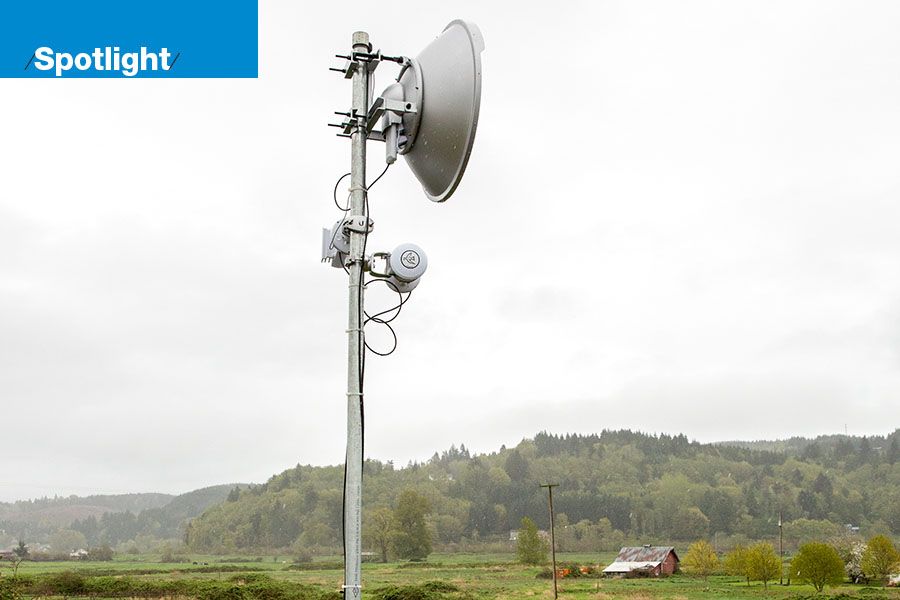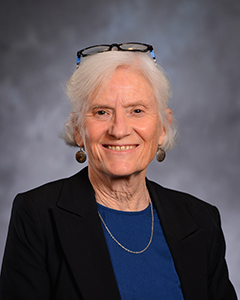Written by Sander Gusinow for Oregon Business

A historic federal investment in rural broadband will determine the future of Oregon internet access for generations.
“In some cases big providers will be the best solutions. Other times community-based providers will be what’s best,” says Rep. Pam Marsh (D-Ashland). “This is not going to be a top-down process. It’s an all-hands-on-deck moment, and all ideas are on the table.”
Marsh is chief sponsor of HB 4092, which passed out of the Oregon Legislature at the beginning of March and was signed into law later that month. The bill establishes the grant-review process for the Oregon Broadband Advisory Council to select projects for an influx of federal funding intended to improve broadband access in underserved communities.
As part of the Infrastructure Investment and Jobs Act — the $1.2 trillion federal investment into infrastructure signed into law last November — $42.45 billion will be allocated to state agencies through the Broadband Equity, Access & Deployment Program (BEAD). The money is meant to fund last-mile broadband development projects, with the goal of bringing broadband to the entire country. The term “last-mile,” in this context, refers to the final leg of the telecommunications network’s delivery of components to the end user.
Last-mile development is particularly difficult for homes in rural and frontier areas, where 16% of Oregon’s population currently lives, according to the United States Department of Agriculture.
As part of BEAD, Oregon will receive a minimum of $100 million to fund rural broadband developments, but Daniel Holbrook, broadband manager at Business Oregon’s broadband office, says the final dollar amount could easily be more than double that, depending on how the program is structured.
That’s on top of $157 million in broadband funding already allocated to Business Oregon under the American Rescue Plan Act, which passed last March.
“However much money we get, this is going to be a historic investment,” Holbrook says. He says Oregonians’ ability to connect to the internet is “essential” to meet the demands of future households.
Marsh concurs, calling the funding “a once-in-a-generation game changer.”
Holbrook’s office is increasing staffing, and is also conducting a mapping operation to ensure the BEAD program will have the newest and most sophisticated data sets available for Oregon when determining the size of the state’s BEAD funding.
Business Oregon has also applied for the Tribal Broadband Connectivity Program, a $980 million initiative to direct funds to Tribal governments to be used for broadband deployment on Tribal lands.
“We are working with some of our partners for training and workshops to talk to the Tribes and listen to them. We have to ask ourselves, ‘Are we the best partner or is it someone else?’” says Holbrook.
Just 5% of Oregonians lack access to the internet, according to broadband office data. But one-third of the state’s residents do not have access to internet speeds compatible with distance learning and remote work.
But solving the problem is logistically complex — and requires significant up-front investment. Connecting all of Oregon will also involve the state entering into partnership agreements with multiple telecommunications companies to lay the necessary fiber.
“The private sector has been the primary group that has invested in the telecom space, so they will pay a significant part,” Holbrook says.
But the amount of private involvement, including the question of how much of this new fiber will be privately and publicly owned, has yet to be seen.
“Obviously there are cost implications involved in the construction of the network, and the further out you get, the costs — generally speaking — get a little higher,” says Ryan Luckin, vice president of marketing at the internet service provider Ziply Fiber, which is headquartered in the Seattle area but has a significant presence in Oregon. Federal funding will mitigate those costs, he says.
But the BEAD fund has its critics.
“The way the legislation is written is to target rural areas. It’s not a horrible thing to do, but there are just as many disconnected people in urban areas, and most urban areas are considered ‘served’ under the definition,” says Russell Senior, president of Personal Telco, a nonprofit wireless network, and president of Municipal Broadband PDX, a nonprofit that advocates for publicly owned fiber networks in Multnomah County.
“There’s a little area of wiggle room, but the thrust of the spending is for where there is no existing infrastructure.”
Business Oregon’s Rural Broadband Capacity Program that ran from 2020 to 2022 required applicants to live in an “unserved” area. Senate Bill 1603, passed during the 2020 legislative session, granted $5 million annually to broadband expansion, but only for areas where no provider was offering 25 megabits per second. The requirement meant urban areas were unable to apply.
Senior says that even though most urban areas have at least one internet service provider, not everyone can afford it.
“There’s no rate regulation, and it produces a near monopoly in the urban areas, so there’s sort of a disequity,” he adds.
Census data from 2019 showed nearly 10% of African American residents in Multnomah County owned a computer but had no internet access — more than double the rate of non-Hispanic whites in the area.
Having a single private entity build into an area may be cheaper from the outset, but Senior says such projects could be damaging to a community in the long run.
“With projects like this, they say, ‘Don’t overbuild,’ but the only way to have competition is to overbuild. Right now there are not a whole lot of places where there’s robust competition for broadband,” says Senior, who compared the current private-access model to a situation in which private companies owned city streets and highways.
“Fiber should be treated as a road or an electrical cable. There are people who say it’s too expensive to get fiber to everybody, but that’s crap. I would give the federal funds to rural open-access fiber and figure out a way to fund an open-access fiber model in Portland,” Senior says.
Lynn Ewing, the mayor of Maupin — a town of about 400 people in Wasco County, on the Deschutes River — says his city’s publicly owned fiber network has given residents the tools to build a bright future.
“We’ve maintained ownership of the fiber, and maintaining ownership is key. It helps us keep a lid on the cost,” says Ewing. “We have two companies on the network, and they keep each other in line so the price stays low.”
Ewing says nearly 100% of residents have internet access, and the city is looking into a cloud program to include houses on private roads. He says broadband access, and the publicly owned fiber in particular, has given the city the new tools to build a bright future.
A 2018 study from Harvard University showed that community-owned fiber networks were less expensive than comparable service offered by a private competitor. The study also found publicly owned networks to be more transparent about how they presented pricing, avoiding “teaser rates” that lead to a sharper price rise.
Marsh says she does not oppose — nor endorse — any one particular method of getting people broadband. She is in favor of creating partnerships with community anchors — like schools, libraries and medical facilities — so they can serve as a mediator between public and private interests, and that can work in both urban and rural areas to create competitive, publicly owned fiber.
For telecommunications company Comcast, the historic investment in broadband support means getting a few steps ahead of the competition.
This year, following broadband forays into Woodburn and Hubbard, Comcast announced it would spend more than $10 million to expand into Silverton, granting access to all residents within city limits.
To keep their services accessible to as many customers as want it, Comcast conducts outreach to connect customers with the Affordable Connectivity Program — an FCC-established benefit program that provides a $30 monthly reimbursement for broadband to eligible households, and up to $75 per month for residents on qualifying Tribal lands.
Rebecca Brown, senior director of community impact at Comcast Oregon/ Southwest Washington, says keeping the company’s most basic internet service — Internet Essentials — below the $30 threshold was a matter of digital equity. Internet Essentials costs $9.95 per month, but with the ACP benefit, customers can get it for free. In March 2020, Comcast increased the speed of the Internet Essentials package from 15 megabits per second to 25 mbps, the minimum to meet the Federal Communications Commission’s definition of broadband. In 2021, Comcast increased speed again to 50 mbps.
Clatskanie-based telecom startup Althea is an example of yet another model for increasing access: a dish service private citizens can use to beam in broadband, then lease the service to neighbors. Althea then collects a fee, making the model similar to franchising arrangements more common in food service and retail.
CEO Deborah Simpier says that growing frustrations with big telecom companies and the onset of COVID-19 have given her company more business than ever.
And since cable does not have to be installed, satellite access works much better in rural areas.
Simpier has worked with federal grant money before, and says government entities need to look at nontraditional methods of funding broadband if the federal dollars hope to bring lasting change to Oregon’s digital divide.
“You need the internet now for health care access. It’s essential for freedom of communication, education, so we have to do whatever we can to ensure everyone has access,” says Simpier. “The internet is what allows people access to their core freedoms.”
